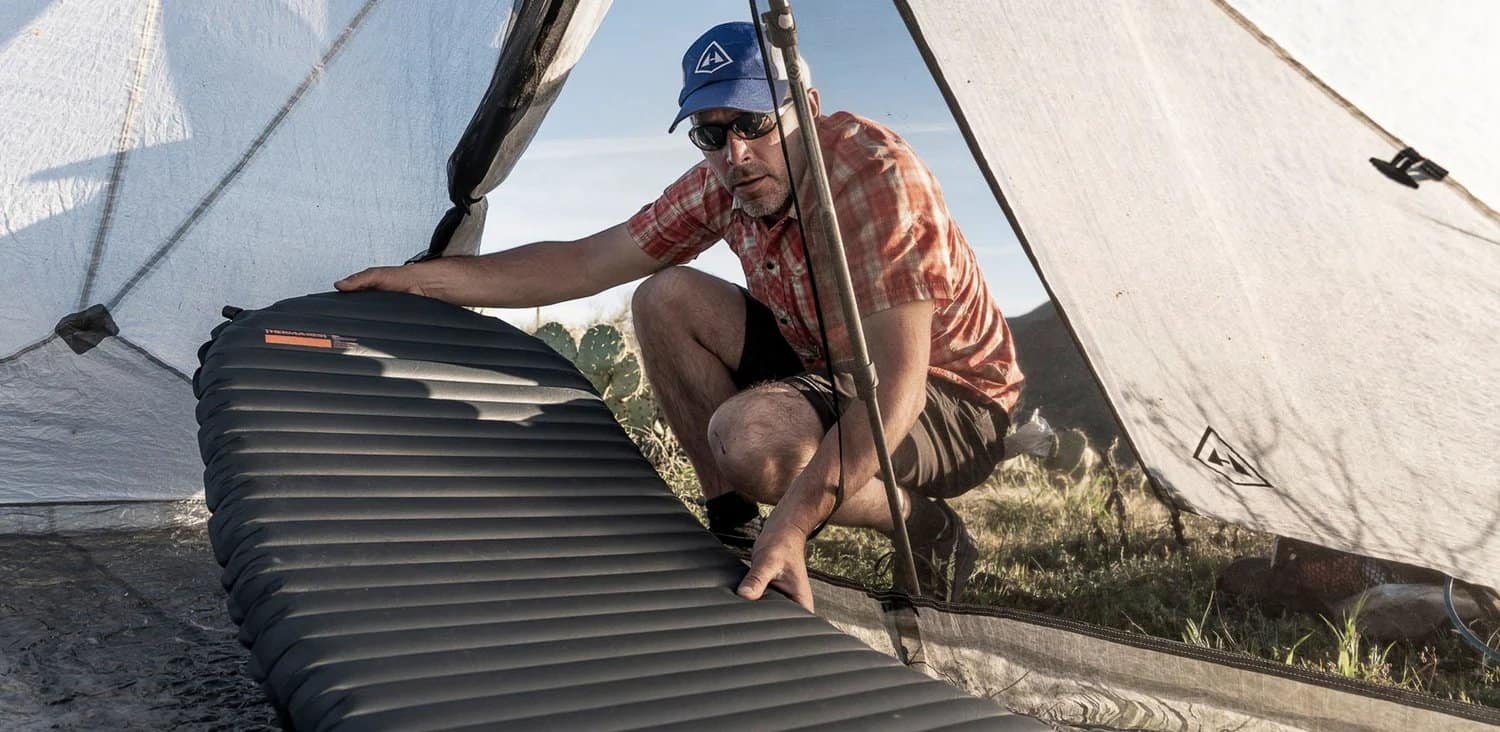はじめに
自分の世界を背中に背負うときは、1オンス(約1.5kg)単位が重要です。従来のスリーピングパッドは、荷物の重量を2ポンド(約1.5kg)も増やしてしまうことがあり、肩や背中がすでに疲れている長距離トレッキングでは大きな負担となります。この重さと快適さのジレンマは、多くのバックパッカーに痛みを伴う妥協を強いることになります。
超軽量スリーピングマットはこの方程式を一変させました。従来のものより70%も軽い、わずか8~16オンスの重量で、パックの重量を劇的に軽減しながら必要不可欠な快適さを提供します。この革新的なマットは水筒サイズに圧縮され、貴重なスペースを食料、水、その他の重要なギアのために解放する。しかし、このマットの背後にあるテクノロジーは、単に重量を減らすことではなく、余分な重量を減らしながら必要なサポートと断熱性を維持することにある。
現代の超軽量スリーピング・ソリューションには、ほんの10年前には不可能と思われた先進的な素材や構造技術が取り入れられている。超軽量素材と強化された断熱技術の組み合わせは、様々な地形や予測不可能な天候に直面するバックパッカーにとって特に重要なものとなっている。R値、様々な寝姿勢に必要な厚み、耐久性を理解することは、あなたのアウトドアアドベンチャーに適した超軽量スリーピングマットを選ぶために不可欠です。
超軽量スリーピングマットを理解する:軽量革命
バックパッキングの世界では、ギアの考え方が大きく変化し、本格的なハイカーやキャンパーにとって軽量化が最優先事項となっている。この革命の中心にあるのが超軽量スリーピングマットで、荷物の重量を最小限に抑えながら快適性と保温性を提供する、必要不可欠な装備品です。アウトドア愛好家がより遠くへ、より長く冒険を続けるにつれ、より軽量でコンパクトなスリーピング・ソリューションへの需要が高まり、素材やデザインに目覚ましい革新が起こりました。
「超軽量スリーピングマットは、最小限の重量と必要不可欠な快適性と保温性のバランスを保ち、バックパッカーがバックカントリーで安眠を維持しながら遠くまで旅することを可能にする。
超軽量スリーピングマットとは?コアの定義と重量パラメーター
超軽量スリーピングマットは特別にデザインされたスリーピングパッドで、重量は通常16オンス(454グラム)以下です。これらの軽量スリーピングパッドは、機能的な快適性と断熱性を維持しながら重量を削減するために、高度な素材と構造技術を使用しています。ほとんどの超軽量モデルは8~15オンスで、中には6オンスという最先端のものもある。
ウルトラライトの呼称は、単に重量を意味するのではなく、1グラム1グラムに疑問を投げかけ、あらゆる面で効率を追求する設計哲学を表している。メーカー各社は、慎重な素材選びと、不要なコンポーネントを排除した革新的な構造設計により、軽量化を実現している。
重量革命:トラディショナルからウルトラライトまで
従来のスリーピングパッドは2~4ポンドの重さがあり、バックパックの中で大きな負担となっていました。超軽量モデルへの移行により、この重量は最大75%まで削減され、ハイカーは持ち運ぶ荷物を減らしたり、必要なアイテムを追加したりすることができるようになりました。この変化は、継続的な材料科学の進歩と独創的なエンジニアリング・ソリューションによるものです。
現代の超軽量スリーピングマットは、リップストップ・ナイロンのような高強度・軽量素材に特殊コーティングを施し、緻密に計算された気室設計により、素材の使用量を最小限に抑えながら強度を最大限に高めています。この進化により、これまで以上に多くのアウトドア愛好家が軽量バックパッキングにアクセスできるようになりました。
圧縮の優位性:超軽量マットがパックスペースを最大化する方法
軽量化だけでなく、超軽量スリーピングマットには優れたパッキング性能がある。多くのコンパクトなスリーピングマットは、水筒かそれ以下のサイズに圧縮されるため、他のギアを収納するスペースが増える。このスペース効率は "ゲームチェンジャー" 限られたパックのスペースにすべての装備を収めなければならないバックパッカー向け。
最高のウルトラライトマットは、小さなパッキングサイズとクイックインフレーションシステムを兼ね備えており、トレイルでの長い一日の後、キャンプの設営をより素早く、労力をかけずに行うことができる。多くのハイカーがスリーピングマットをギアシステムにおける重要な投資と考えている理由は、このような利点の組み合わせにある。
必要不可欠な三要素のバランス:重量、快適性、断熱性
効果的な超軽量スリーピングマットを作る上での真の挑戦は、重量、快適性、断熱性という3つの相反する要素のバランスを取ることにある。重量を減らすということは、クッション性や断熱性を減らすことを意味することが多いが、最高のデザインはこのバランスを維持する巧妙な方法を見出している。
最近のマットは、ボディマッピング(部分的に厚みを変える)、反射層、戦略的バッフルなどの革新的なアプローチを採用し、不必要な重量を増やすことなく暖かさと快適さを最大限に高めています。超軽量スリーピングパッドの利点は、単に持ち運びが少なくなるだけではありません。
超軽量スリーピングマットの比較
| タイプ | 平均体重 | R値(断熱材) | 梱包サイズ | 耐久性評価 | 価格帯 |
|---|---|---|---|---|---|
| エア・コンストラクション | 8~12オンス | 2.0-3.5 | 3" x 6" | ミディアム | $120-180 |
| 自己膨張 | 12~16オンス | 2.5-4.0 | 4" x 8" | 高い | $80-150 |
| クローズド・セル・フォーム | 7~14オンス | 1.0-2.5 | 20インチ x 5インチ x 5インチ | 非常に高い | $20-60 |
| ハイブリッド構造 | 10~14オンス | 3.0-5.0 | 4" x 7" | ミディアム-ハイ | $150-220 |
| ウルトラライト・スペシャライズド | 6~9オンス | 1.5-2.0 | 2.5" x 5" | ロー・ミディアム | $180-250 |
超軽量スリーピングマットを選ぶ際には、特定のニーズと典型的なキャンプ条件を考慮してください。小売店やアウトドア・ビジネスでは、以下のような経験豊富なサプライヤーと提携することが重要です。 ケリーランド・アウトドアーズ は、重量を重視する顧客に最適な仕様のプレミアム軽量アウトドアギアを提供している。
彼らの専門知識は、超軽量スリーピング・ソリューションの技術的側面をナビゲートし、軽量でありながら快適な選択肢を求める需要の高まりに応える製品選択を保証する。業界は進化を続けており、最も有望な開発は、超軽量素材と強化された断熱技術の組み合わせである。

素材と構造:超軽量性能を支える技術
すべての超軽量スリーピングマットの裏には、先進素材と革新的な構造技術の高度な融合があります。最新のスリーピングシステムで達成された驚異的な軽量化は偶然ではなく、意図的なエンジニアリングと材料科学の飛躍的進歩の結果なのです。これらの要素を理解することで、アウトドア愛好家は十分な情報に基づいた選択をし、一見シンプルでありながら技術的に複雑な製品の価値を理解することができます。
「超軽量スリーピングマットの性能は、主にその素材構成と構造技術に左右される。
先進素材:リップストップナイロン、TPU、その他の超軽量素材
最近の超軽量スリーピングマットは、最小限の重量と最大限の耐久性のバランスを保つ特殊な生地を使用している。リップストップナイロンはデニール数15Dから40Dのものが多く、多くの高級品のアウターシェルとなっている。これらの生地には、小さな裂け目が広がるのを防ぐクロスハッチパターンの補強糸が組み込まれている。
熱可塑性ポリウレタン(TPU)コーティングは、重量を最小限に抑えながら気密シールを実現します。従来のPVCコーティングとは異なり、TPUは低温下での柔軟性に優れ、加水分解(湿度の高い条件下での分解)にも強い。メーカーによっては、現場環境での構造的完全性を維持しながらさらに軽量化する独自の混合生地を開発しています。
断熱技術:エアチャンバー、フォーム、ハイブリッドシステム
超軽量スリーピングマットの断熱システムは、最も革新的なデザインのひとつです。エアースリーピングマットは、バッフル、気室、チャンネルといった内部構造を精密に設計し、素材の使用量を最小限に抑えながら暖かい空気を閉じ込める。これらの設計は、対流によって冷たい地面が体温を奪うのを防ぐ。
ピュア・エア・マットが最も軽量である一方、断熱スリーピング・パッドはプリマロフト、合成マイクロファイバー、ダウンなどの素材を取り入れて熱効率を高めている。ハイブリッド・システムは、気室の利点と戦略的なフォームの配置を組み合わせたもので、メーカー各社は次のようなものを生み出している。 "スイートスポットを呼ぶ" 重量と断熱性の関係超軽量スリーピングマットがどのように断熱効果を発揮するかは、素材の厚さよりもむしろ、こうした内部構造要素に左右されることが多い。
R値を理解するさまざまな条件の温度定格
R値はスリーピングマットの熱流に対する抵抗力を測定するもので、数値が高いほど断熱性が高いことを示す。2020年以降、業界は標準化された試験(ASTM F3340-18)を採用し、ブランド間で一貫した評価を提供しています。これにより、特定の温度範囲に対応するマットを選ぶ際に、信頼できるデータを得ることができる。
夏のバックパッキングでは通常R値1~2、3シーズン使用ではR値2~4が求められる。冬のキャンプではR値4以上が要求され、極端な条件では5以上が必要となる。超軽量設計の課題は、重量や嵩を大幅に増やすことなく、これらの高いR値を達成することです。
強度重量比を最大化する建設技術
超軽量スリーピングマットの製造方法は、その性能に大きく影響します。縫い目ではなく熱溶着することで、より丈夫で軽い縫い目を作り出し、空気漏れの可能性を排除します。コンピューター制御による裁断は、材料の正確な利用を保証し、無駄と不必要な重量を削減します。
内部バッフルのデザインは、超軽量スリーピングマットの構造におけるもうひとつの重要な側面です。水平バッフルは安定性と快適性を提供するが、より多くの材料を必要とする。垂直バッフルは重量を減らすが、膨らませたときに不快な「タコ効果」を引き起こす可能性がある。三角形やオフセット・パターンなどの高度なデザインは、素材の使用量を最小限に抑えながら安定性を最大化します。
超軽量スリーピングマットの素材と構造の比較
| 素材/構造タイプ | 重量インパクト(g/m²) | 耐久性評価(1~10) | R値寄与率 | 温度範囲 | 生産の複雑さ |
|---|---|---|---|---|---|
| 15Dリップストップナイロン | 35-45 | 4 | 0.1-0.2 | オールシーズン | ミディアム |
| TPU付き20Dポリエステル | 50-60 | 6 | 0.1-0.3 | オールシーズン | ミディアム |
| 合成マイクロファイバー断熱材 | 100gあたり40~60 | 7 | 1.5-2.5 | 3シーズン | 高い |
| 反射層テクノロジー | 5-15 | 8 | 1.0-2.0 | オールシーズン | ミディアム-ハイ |
| オープンセル・フォーム・ハイブリッド | 80-120 | 9 | 2.0-3.0 | 4シーズン | 高い |
| 溶接バッフル構造 | デザインにより異なる | 8 | 0.5-1.0 | オールシーズン | 非常に高い |
超軽量スリーピングマット市場への参入を目指す企業にとって、知識豊富なサプライヤーとの提携は不可欠です。ケリーランドは、最先端の素材や技術を活用する専門メーカーとの関係により、技術的に高度なスリーピングソリューションを調達するための貴重なパートナーとして位置づけられています。最新の超軽量マット技術を開発する工場との協力的なアプローチは、最適な技術仕様の製品へのアクセスを保証します。
アウトドア産業が進歩するにつれ、超軽量素材と強化された断熱技術の組み合わせは支持を集め続けており、小売業者にとっては、軽量かつ快適な原野用スリーピング・システムに対する需要の高まりに応える大きなチャンスとなっている。
完璧な超軽量スリーピングマットを選ぶ:重要な基準
適切な超軽量スリーピングマットを選ぶことは、あなたのバックパッキング体験を左右します。重さ、厚さ、断熱性、機能など、さまざまな選択肢がある中で、最適なものを見つけるには、それぞれの特徴がバックカントリーでの快適さ、荷物の重さ、睡眠の質にどのような影響を与えるかを理解する必要があります。十分な情報を得た上で決断を下すには、これらの要素を自分の特定のニーズや冒険スタイルと照らし合わせ、バランスを取る必要があります。
「理想的な超軽量スリーピングマットは、軽量化と、冒険のコンディションやスリーピングスタイル、個人的な快適さの好みに応じた十分な快適性と断熱性のバランスがとれている。
体重に関する考察:完璧なバランスポイントを見つける
超軽量スリーピングマットのカテゴリーには通常16オンス以下のパッドが含まれるが、この範囲内でもかなりのバリエーションが存在する。9オンスと14オンスのマットの差は、パック重量の約3分の1に相当する。9オンスと14オンスのマットの差は、パックの重さの3分の1ポンド近くに相当する。この重さの差は、複数日または困難な地形で意味を持つ。
しかし、最も軽いものが自動的に最良の選択というわけではない。体型、睡眠習慣、旅行期間などを考慮して選びましょう。大柄な人はより広い面積と厚みが必要かもしれませんし、横向き寝の人は一般的に圧迫点を防ぐためによりクッション性が必要です。長期の旅行では、睡眠の質と疲労回復に優れた少し重めのマットが適しているかもしれません。
厚みと寝心地:寝姿勢に合わせたマットデザイン
超軽量マットは通常、膨らませた時の厚さが1.5~3.5インチ。あなたの寝姿勢がこの決定に大きく影響するはずです。一般的に、横向き寝の人は腰や肩の圧迫点を防ぐために厚めのマット(2.5インチ以上)が必要で、仰向け寝の人は薄めのもの(1.5~2インチ)でなんとかなることが多い。
厚さだけでなく、バッフルのデザインも考慮してください。水平バッフルは枕の中心を保つ傾向がありますが、不快な "タコ効果 "を引き起こす可能性があります。縦長のバッフルはこの問題を最小限に抑えますが、不安定に感じることがあります。バックパッキング用スリーピングパッドの中には、以下のようなハイブリッド構造やセルラー構造のものもあります。 "正鵠を射ている" 最小限の重量を維持しながら安定性を確保する。
季節の条件アドベンチャータイプに合ったR値の選択
マットのR値は断熱性に直接影響します。夏のコンディションでは、通常R値1~2のマットで十分です。スリーシーズンのバックパッキングではR値が2~4程度、冬のキャンプでは4.5以上が必要です。コンディションに見合わない断熱性のマットを選ぶと、夜間の熱損失が不快になったり、危険な状態になることもあります。
特定の温度範囲に対応するウルトラライト・スリーピングマットの選び方を評価する場合は、メーカーごとに異なる温度範囲ではなく、標準化されたASTMのR値評価に特に注意を払うこと。ウルトラライト愛好家の中には、R値の低いマットと薄いフォームパッドを組み合わせることで、過剰な重量を背負うことなく季節を問わず適応できるようにしている人もいる。
膨張メカニズム:自動膨張式と手動式の比較
携帯用スリーピング・ソリューションのインフレーション・システムは、フィールドでの使用感に大きく影響します。手動式の膨張パッドは一般的に重量が軽いですが、長時間のハイキングの後には労力を必要とします。自動膨張式のものは重量が増えますが、便利です。超軽量モデルの中には、重量を最小限に抑えながら、湿気による膨張を防ぐポンプを内蔵したものもある。
膨張・収縮のスピードや硬さの微調整に影響するバルブのデザインも考慮しよう。一方向の膨張と個別の収縮機構を可能にする最新のバルブは、単純なツイストバルブと比較して、現場で大きな利点を提供する。
超軽量スリーピングマットの選択基準比較
| ユーザータイプ | 推奨重量 | 最適な厚さ | 理想的なR値の範囲 | 推奨インフレ・タイプ | 素材の耐久性 |
|---|---|---|---|---|---|
| ウィークエンド・バックパッカー | 10~14オンス | 2.0-2.5" | 2.0-3.0 | 自己膨張式 | 30D+ |
| ウルトラライトスルーハイカー | 6~10オンス | 1.5-2.0" | 1.5-2.5 | 手動/ポンプサック | 20D-30D |
| サイド・スリーパー | 12~16オンス | 2.5-3.5" | 2.0-3.5 | タイプ | 30D+ |
| 冬のキャンピングカー | 14~18オンス | 2.0-3.0" | 4.5+ | 統合ポンプ | 40D+ |
| 予算重視 | 8~12オンス | 1.5-2.0" | 1.5-2.5 | マニュアル | 20D-40D |
| 快適さ優先 | 12~16オンス | 3.0-3.5" | 3.0-4.0 | 自己膨張式 | 30D-40D |
アウトドアショップにとって、このような様々なニーズに対応する品揃えを提供することは非常に重要です。ケリーランドのカスタマイズ機能により、小売パートナーは特定の顧客層や冒険のタイプに合わせた特別なウルトラライト・スリーピング・ソリューションを開発することができます。例えば、重量を最小限に抑えたウルトラライト・スルーハイキング・パッドや、週末戦士向けの快適性重視のオプションなどです。
バックパッキングに最適な超軽量スリーピングマットは、結局のところ、使う人の優先順位とコンディションに左右される。業界は進化を続けており、最もエキサイティングな開発は超軽量素材と強化された断熱技術の交差点で起こっている。この組み合わせは、従来の重量と保温性の妥協点に対処し、ほんの数年前よりも優れたオールラウンド性能を実現します。
超軽量スリーピングマットの実際:フィールドでの使用例と性能
超軽量スリーピングマットの真価は、実際のコンディションで使用することで明らかになる。灼熱の砂漠から極寒の峠まで、これらの軽量な驚異は、単純な軽量化をはるかに超える実用的な性能の優位性によってその価値を実証する。様々な環境下でこれらのマットがどのように機能するかを理解することは、バックパッカーが特定の冒険に適した装備を選択するのに役立ちます。
「超軽量スリーピングマットは、1オンス単位が重要な長期のバックカントリーの旅で最大の価値を発揮するが、快適性と断熱性の向上という性能上の利点は、短時間の冒険でも同様に価値がある。
スルーハイキングの性能:長旅での軽量化
何百マイル、何千マイルものトレイルに挑む長距離ハイカーにとって、超軽量スリーピングマットは重要な軽量化のチャンスである。1オンス(約1.5kg)を何カ月も持ち運ぶとなると、従来の2ポンド(約1.5kg)のスリーピングパッドと12オンス(約1.5kg)の超軽量スリーピングパッドの差は、かなりの省エネになる。スルーハイカーはしばしば、軽量ギアを選択することで、毎日の走行距離を一定に保つことができるようになったと報告する。
長距離ハイキング用の超軽量スリーピングマットは、一般的に軽量化と同時にパッキングのしやすさを優先している。水筒サイズに圧縮できるスリーピングマットは、食料と水のための貴重なパックのスペースを作り出します。多くの経験豊富なスルーハイカーは、スリーピングマットは手を抜くためのものではなく、必要不可欠な投資だと考えている。
高山および高地での使用:最も重要な時の断熱
季節に関係なく日没後の気温が劇的に下がる高山では、スリーピングマットの断熱性が重要になる。最近の超軽量スリーピングマットは、重量を最小限に抑えながら驚異的なR値(4.0以上)を実現し、伝導によって体温を急速に奪う冷たい地面からユーザーを守っている。
高地でのバックパッカーは、気温の低さと重量過敏性という2つの課題に直面します。最新世代の軽量スリーピングパッドは、リフレクティブ・テクノロジーと戦略的な断熱材の配置により、かさばることなく保温効率を最大化し、卓越した断熱対重量比を実現しています。
夏のバックパッキング最小の重量、最大の快適性
夏のコンディションはバックパッカーに 「ミニマリストに徹する をスリープ・システムと組み合わせている。インサレーション(保温)に対する要求が低くなると、8~10オンスの超軽量スリーピングパッドが登場する。このようなバックパッキング用スリーピングパッドは、バッフルが少なく、素材が薄く、膨張システムが合理化されているなど、シンプルな設計になっていることが多い。
この性能の利点は、単に持ち運びが軽くなるだけにとどまらない。夏用のウルトラライトマットは通常、荷物が小さくなり、夏用の合理的なパックに収納しやすくなる。また、設営と撤収が早いので、朝の出発や夜のキャンプへの到着がより効率的になる。
完全なスリープ・システム内の超軽量マット
超軽量スリーピングマットは、総合的なバックカントリースリープシステムの基礎として機能する。適切な 寝袋 あるいは掛け布団やシェルターと組み合わせることで、睡眠の質を維持あるいは向上させながら、スリーピング・キット全体の大幅な軽量化に貢献する。
経験豊富なバックパッカーは、コンディションに応じてコンポーネントを組み合わせます。例えば、ショルダーシーズンにはより軽いマットとより暖かいキルトを組み合わせたり、特定の温度帯ではより高いR値のマットとより軽いバッグを組み合わせたりします。このようなシステムベースのアプローチは、各コンポーネントの汎用性を最大限に引き出します。
超軽量スリーピングマットの様々な環境における性能
| 環境 | 推奨R値 | 最適重量範囲 | 主なパフォーマンスニーズ | セカンダリー・パフォーマンスの必要性 | 典型的なユーザーの優先順位 |
|---|---|---|---|---|---|
| 砂漠(夏) | 1.0-2.0 | 6~10オンス | 耐パンク性 | 最小重量 | 地面からの保護 |
| アルペン(夏) | 2.5-3.5 | 10~14オンス | 断熱 | 耐風性 | 熱効率 |
| フォレスト(3シーズン) | 2.0-3.0 | 8~12オンス | 快適さ | ノイズ・リダクション | 睡眠の質 |
| 冬のコンディション | 4.5-7.0 | 14~20オンス | 高断熱 | 耐久性 | 安全性/暖かさ |
| 長距離トレイル | 2.0-3.0 | 8~12オンス | 耐久性 | 軽量化 | 距離に対する信頼性 |
| 湿度の高い環境 | 2.0-3.0 | 10~14オンス | 耐湿性 | 速乾性 | カビの予防 |
アウトドア小売業者にとって、Kelyland Outdoorsのような経験豊富な調達サービスとの提携は、さまざまな顧客層に合わせた包括的な軽量スリーピングシステムの開発を可能にする。彼らの専門知識は、週末戦士、スルーハイカー、高山冒険家など、これらの製品の基礎となる超軽量スリーピングマットの最適な仕様を特定するのに役立ちます。
また、ケリーランドは専門メーカーとのコネクションを活かし、超軽量素材と高い保温技術を組み合わせた最新のイノベーションを提供しています。このような知識により、販売店は重量を重視するアウトドア愛好家の進化するニーズに応える最先端の製品を提供することができるのです。
超軽量スリーピングマットのメンテナンス、ケア、寿命延長について
本格的なバックパッカーにとって、高品質な超軽量スリーピングマットに投資することは大きな意味を持ちます。このような軽量スリーピングマットは素晴らしいパフォーマンスを発揮しますが、その機能性を維持し続けるには、適切なメンテナンスと予防的ケアが不可欠です。適切なメンテナンス、クリーニング、修理、保管方法を理解することで、最もミニマルなデザインのスリーピングマットでも、信頼できるサービスを何年も楽しむことができます。
「超軽量スリーピングマットの定期的なメンテナンスは、その使用可能な寿命を大幅に延ばし、適切なケアルーチンは、放置された機器と比較して、有効な耐用年数を倍増させる可能性がある。
フィールド・メンテナンス必須の修理技術とキット
どんなに注意深いバックパッカーでも、エアースリーピングマットに穴が開いたり破れたりすることがある。パッカブルで軽量な超軽量素材を使用しているため、鋭利なものにはやや弱いのだ。本格的なバックカントリー・アドベンチャー、特に失敗が許されない数日間の旅では、適切なフィールド修理キットを携帯することは譲れない。
包括的な修理キットには、接着パッチ(永久的なものと一時的なものの両方)、シームシーラー、特定のモデルに適したバルブ交換部品、軽量アプリケーターが含まれている必要があります。水没法(水がある場合)またはリスニング法(乾燥している場合)を使ってパンクの位置を適切に特定することを学ぶと、現場での修理成功率が大幅に向上します。
長持ちさせるためのクリーニングと保管のベストプラクティス
適切なクリーニングは素材の劣化を防ぎ、適切な保管はコンパクトなスリーピングマットの構造的な損傷を防ぎます。防水コーティングや接着剤を劣化させる刺激の強い化学薬品は避けてください。特にバルブには注意が必要です。バルブには汚れがたまりやすく、機能が損なわれることがあります。
マットを保管する際は、直射日光の当たらない涼しく乾燥した場所で、マットを部分的に膨らませた状態(またはバルブを開いた状態)で保管してください。こうすることでカビの発生を防ぎ、内部のバッフルや縫い目へのストレスを最小限に抑えることができます。ウルトラライトマットの故障の多くは、実際のフィールドでの使用ではなく、不適切な保管に起因しています。
よくあるダメージを防ぐパンク、剥離、バルブの問題
予防が最も効果的なメンテナンスであることに変わりはありません。スリーピングシステムを設置する前に、キャンプ場から鋭利なものを取り除くこと。グランドクロスやテントのフットプリントを使用すると、マットと潜在的な危険物の間に追加の保護層ができます。これらの簡単なステップで "ベーコンを守れ" パンクの危険性がある未知の地形でキャンプする場合。
層間剥離は、内部の層が圧力や湿気、熱によるダメージによって分離することで起こります。これを防ぐには、(特に暑い季節には)膨らませすぎを避け、可能な限りマットを乾いた状態に保つことです。バルブの不具合は通常、汚れの混入やクロススレッドによって生じますが、取り扱いに注意し、時々綿棒でクリーニングすることで簡単に防ぐことができます。
交換のタイミング寿命の指標を認識する
優れたメンテナンスを行っても、すべての超軽量スリーピングマットは最終的に耐用年数を迎えます。主な指標としては、何度も補修を試みたにもかかわらず水漏れが続く、マットの表面の20%以上に影響する著しい層間剥離、補修不可能なバルブの損傷、目に見える素材の劣化(脆さや剥がれなど)が挙げられます。
ほとんどの高品質なウルトラライト・スリーピングマットは、適切な手入れをすれば300~500泊は使用できるはずです。買い替えが必要になったら、最新の素材とデザインの革新の恩恵を受けるチャンスだと考えましょう。
超軽量スリーピングマット・メンテナンス&修理ガイド
| 問題の種類 | 予防法 | 現場での修理技術 | 必要なツール | 長期的な解決策 | メンテナンス頻度 |
|---|---|---|---|---|---|
| 小さなパンクチャー(<3mm) | グラウンドクロスの使用 | 粘着パッチの適用 | パッチキット、石鹸/水 | パーマネントパッチまたはシームシーラー | 走行後の点検 |
| 大きな裂傷(3mm以上) | 慎重な用地選定 | 一時的なパッチ+デフレーション | 粘着テープ、はさみ | プロフェッショナルな修理サービス | 構造上の問題であれば交換する。 |
| バルブの故障 | 清潔に保ち、取り扱いに注意 | 現場で交換可能な部品 | バルブツール、交換部品 | バルブ全交換 | 15~20回使用するごとに清掃する |
| デラミネーション | 適切なインフレ・レベル | 現場修理不可 | 該当なし | 保証請求(該当する場合 | 四半期ごとの検査 |
| カビ | 保管前に完全に乾燥させる | 希釈酢液 | 柔らかい布、中性石鹸 | 紫外線を浴びる(制限あり) | 湿度の高い環境での洗浄 |
| バッフルの故障 | オーバーインフレーションを避ける | 現場修理不可 | 該当なし | 専門家による修理または交換 | 長期出張前の点検 |
Kelyland Outdoorsと提携している小売店は、調達したすべての超軽量スリーピングソリューションが耐久性基準を満たしていることを保証する、同社の厳格な品質保証プロセスの恩恵を受けることができます。膨張サイクルテスト、耐パンク性の検証、バルブの機能性評価など、包括的なテストを実施し、長期間の使用でも顧客満足度を維持できる製品を提供しています。このような品質へのこだわりは、最終的に保証クレームを減らし、ブランド・ロイヤルティを築きます。
超軽量スリーピングパッドのメンテナンス方法を理解することは、耐用年数を延ばすだけでなく、最も必要なときに信頼できる性能を発揮することを保証します。このようなお手入れ方法を実践し、その知識を顧客と共有することで、アウトドアショップはこのような必要不可欠なギアの価値を高めることができるのです。
結論
で10年を過ごした後 キャンプ用品 この業界で、私はスリーピングマット技術の驚くべき進化を目の当たりにしてきた。最も驚かされるのは、ほんの数年前までは不可能に思えた快適さを、現在の超軽量スリーピングマットが実現していることだ。
完璧なスリーピングマットとは、単に軽量化することではなく、軽量化、保温性、快適性があなたのアドベンチャースタイルに合致するスイートスポットを見つけることです。サイドスリーパーでクッション性を重視する人も、スルーハイカーで1オンス単位の重量を気にする人も、今日の革新的なデザインは、痛みを伴う妥協なしに解決策を提供します。
適切なお手入れとメンテナンスをすれば、高品質の超軽量スリーピングマットは、1年中使うことができる。 "ゲームチェンジャー" をあなたのギア・システムに加えることで、荷物を軽量化しながら荒野での睡眠体験を変えることができます。毎晩、何マイルも歩くことになるのだ。
よくあるご質問
-
Q1: 超軽量スリーピングマットとは何ですか?
A1: 超軽量スリーピングマットは、バックパッキングやキャンプ用にデザインされた軽量で持ち運び可能なスリーピングパッドです。パッキングが簡単でありながら、快適さと断熱性を提供します。
-
Q2: 超軽量スリーピングパッドは普通のスリーピングパッドと比べてどうですか?
A2: 超軽量スリーピングパッドは一般的に通常のパッドよりも軽量でコンパクトなため、バックパッカーに最適です。軽量化のために寝心地や保温性が犠牲になることもあります。
-
Q3: 超軽量スリーピングパッドを購入する際、何を見ればいいですか?
A3: 超軽量スリーピングパッドを購入する際は、重さ、梱包性、R値(断熱性)、厚さなどの要素を考慮し、快適性を重視すること。
-
Q4: 超軽量スリーピングパッドはキャンプに十分快適ですか?
A4: そう、多くの超軽量スリーピングパッドはキャンプで十分な快適さを提供するようデザインされており、より良いサポートのためにクッション性と断熱性を高めたモデルもある。
-
Q5: 超軽量スリーピングマットは冬でも使えますか?
A5: そう、超軽量スリーピングマットの中には冬の使用に適したものもある。
-
Q6: 超軽量スリーピングパッドの重さは?
A6: 超軽量スリーピングパッドは通常15オンス(430グラム)以下で、さらに軽いモデルもある。
-
Q7: 超軽量スリーピングマットを使う利点は何ですか?
A7: 超軽量スリーピングマットの主な利点は、バックパッキング時の軽量化、コンパクトなパッキングサイズ、持ち運びの容易さなどで、ミニマリストのアウトドアアドベンチャーに理想的だ。
-
Q8: 超軽量スリーピングパッドは丈夫ですか?
A8: ウルトラライトのスリーピングパッドは耐久性を重視して設計されていますが、軽量な素材のため、重量のあるモデルに比べて摩耗や破損の影響を受けやすい場合があります。適切なケアと使用により、寿命を延ばすことができます。
